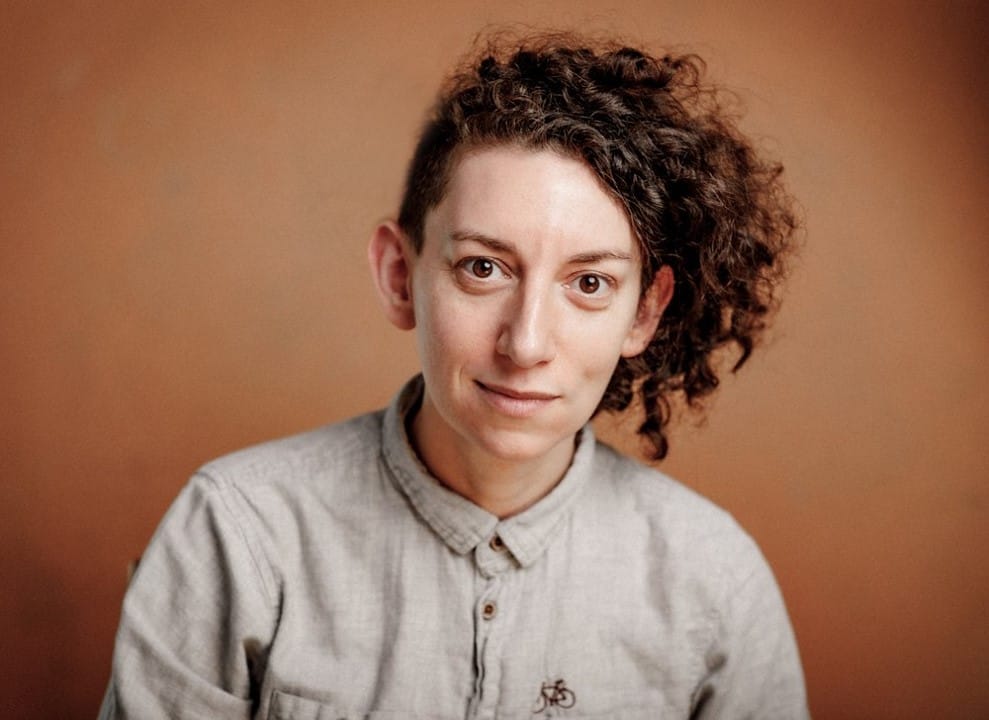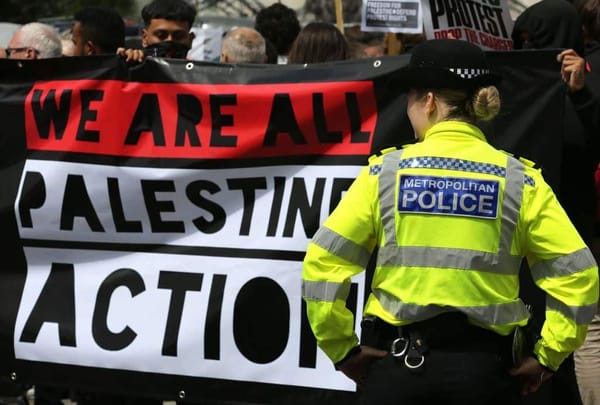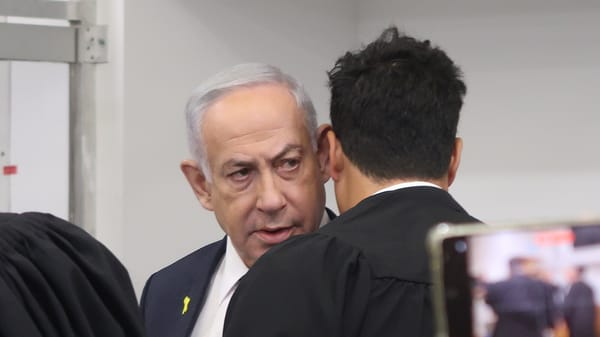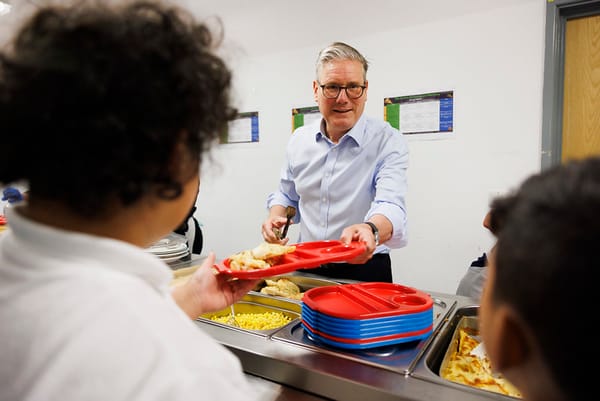My live Jewish body
Vashti meets queer Jewish performance maker Rachel Mars.

I first encountered performance maker and writer Rachel Mars when she guest lectured a day’s workshop at my drama school; I had recently relocated from New York (via Los Angeles) to London and was struggling with a perceived dearth of Jewish community in the arts. We became better acquainted upon attending Asylum Arts’ Intermission retreat for Jewish artists in 2019, and in the activism around Jewish representation in the arts. Since then, I have had the honour of exchanging late-night dramaturgical offerings via WhatsApp with Rachel on subjects including blood libel, Jewish joy, pickles and creating the Jewish spaces we did not have as younger artists.
Last week, Rachel returned to the Barbican with her durational installation FORGE, developed on their Open Lab programme in 2019 and premiering at Transform Festival in Leeds in 2022. This week, FORGE is being hosted at Bristol’s Mayfest from 25-27 May. FORGE asks the audience to bear witness as Rachel welds together a replica of the replica of the entrance gate at Dachau concentration camp (the original gate was stolen in 2014, then replicated by a local blacksmith), in conversation with a live soundscape from sound artist Dinah Mullen.
Working both as a solo artist and in collaboration with artists such as Greg Wohead, Rachel’s practice sits at the intersection of live art, writing and performance, while wrestling with her identity as a queer, British, Jewish woman. Her previous work includes ROLLER (Oxford Samuel Beckett Trust Award), Our Carnal Hearts (Total Theatre Award), and Your Sexts Are Shit: Older Better Letters. And during lockdown, Rachel began reviewing gherkins for her series Picklewatch Reviews.
Ahead of FORGE’s run at the Pit at the Barbican last week, I jumped on a Zoom call with Rachel to discuss Holocaust memorialisation and the ways our inherited trauma shapes the art we create. This interview has been condensed for clarity.

Emma Jude Harris: What do you feel is your “inheritance” as a Jewish person?
Rachel Mars: Well, this came up in therapy this week – so the need to go to therapy is the first one.
I think obviously the answer is multiple and complex. As a Jewish person, I have inherited many things that are joyful and to be celebrated: a love of language, and argument, and disagreement, and debate, a certain type of love for a certain sense of humour, the need for a particular kind of community, and also a helpful feeling of otherness in Britain. But also an unnamed grief or sadness – I don’t think that’s all Jews, I think that’s this Jew – because of Holocaust inheritance. I’ve inherited a big hole where there should be a lot of other people and their histories and their lives where there are none.
So it’s all of those things – mostly it feels joyous and full of celebration, but it can also feel heavy and full of rage and injustice. There you go. Will that do?
Well, that has just made me cry, so yes, I think that will do.
We’ve spoken before about this concept of being out as Jewish in a UK theatre industry where Jewish identity is not always visible. For you, as a queer Jew making art that is at times queer and Jewish, how does it affect you to be doubly out in a sense?
I think it’s really artistically helpful. Like I’m observing a nominally Christian country from the position of a Jew, and I’m observing a [society] that has been set up in heteronormativity from a queer point of view. So at any given moment, I’ve got two outsider perspectives from which to look in.
The outness – I have never been “in” as a Jew. That’s not an option for me: it’s just hiding again [which] is doing a fucking disservice to people generations before. So I think the double outness feels like a gift actually, for perspective and for another place of societal analysis, which I love.
Can we take a moment to honour your Jewish ancestors who presumably emigrated to England from Europe, I believe Germany, at some point? And would you mind telling me a family story about one of them?
Yes. My dad’s lot came during the pogroms, from Lithuania, so a generation earlier. But the family whose history I’m more in touch with, on my mum’s side, came in ’39 from Germany. And god, there’s lots of stories.
My grandma ended up working in fields near her house [in Nottinghamshire] and there were German prisoners of war who saw her walking past them – she had really long red hair – and were like: “Get a look at that.” And she just shot back in German: “Yeah, why don’t you have a really really good look.” And that sort of righteous indignation and direct wit and aggression I’ve definitely inherited from her, and the unashamed fight I think comes from her.

If you’re comfortable sharing, do you feel that your family’s intergenerational trauma – I mean, August ’39 is absolutely wild – has manifested in any tangible ways for you personally? You mentioned therapy…
[My childhood] was very joyful and buoyant on the whole, [but] it wasn’t a family where we didn’t talk about it. I just remember it always being present. So it’s hard to know when I first learned about it, but things get stuck in the body. There are particular medical conditions in my family that I’m not sure aren’t a response to this kind of inheritance.
There’s also a sort of ethic, a pursuit of justice – to a fault, actually – that I think I’ve inherited, which is, again, a bit tiring. But being mindful to really do your fucking best and for things to be fair and ethical.
But also on the flip side, there’s this thing of like, you just fucking live. Life’s too short, live. Don’t hang around, get on with shit. And I think that’s a result of not knowing if your time’s gonna be up soon.
As a Jew who is alive, making work that honours the dead, how do you infuse your work – which deals with this kind of profound and immeasurable loss and absence – with your living, breathing sense of humour, and embodied kind of frank candour? And during the development of FORGE, have you felt any internal or external pressure to either avoid or lean into particular tonalities because of the perceived solemnity and scale of the material?
This is the exact tension sitting at the heart of the work, everything you’ve just described. I think as an audience we’ve got used to watching what I call dead sepia suitcase Jews, and I worry about that being just backwards-looking. The whole question for me at the heart of FORGE is: “How can you be in the present and forwards-facing with this while also doing memorial and being embodied?”
The word I’m always thinking about is “hallowed”. I don’t want it to only be hallowed as a space, and I don’t want it to never be hallowed because then you end up kind of taking the piss and being disrespectful towards your own history because of your own discomfort and other people’s perceived discomfort at the seriousness and their incapability of dealing with it. So it’s this knife edge of tone that I feel like I’m walking all the time. Because what I’m asking you to do as an audience is come and look at my live, Jewish body. [There’s] got to be some chutzpah about it and some disarming.
A lot of that comes in the sound design, where we’ve worked an awful lot with What a Feeling from Flashdance as this kind of pop culture reference to welding – that’s really the only one historically. And I think that is a disarming moment of being like, look we’re in the 80s now, so we’re in the past but the more recent past. It’s trying to do something temporally, like a palimpsest or something where I’m inviting you to watch the past and the present at the same time.
I think in a way for FORGE, pulling the language out stops my role becoming an educative piece. There’s still language in the show, because it’s in the exhibition before and the publication after, but it means that I can just work in both specific and abstract ways, and not worry about a non-Jewish gaze, I suppose.
So it’s hard. It’s the tension and the question in the show for me. I don’t know if I’ve solved it.
I don’t know that it can be solved. I think it’s maybe just about putting it there and grappling with it.

So what is your least favourite Holocaust memorial? And why?
Ooh. I’ve got quite a lot of favourite ones?
I decided to start with least favourite because I thought it’d be fun and slightly more Jewish to start with the negative point of view. But by all means start with the positive one!
In my head, there’s this like, metal, skinny, tortured body abstraction structure, I think it might even be at Auschwitz, that I hate. And then you get into nation-state funded, the classic, you know, six pillars, six shards, six tall things – I just lose interest. It looks like everything else. And it’s often commissioned by nation states that have been party to the damage in the first place.
I remember always thinking Germany did an amazing job of memorialising everything, and that it’s so incredible that they’ve had all these interventions. And then I was speaking to a German Jew recently who said: “Well, yeah, but that’s only because they lost.”
(Laughs). It’s very true. Everyone looked at them and said: “Well, you better.”
But there are also some really good memorials. I like a lot of the anti-memorials that are happening. Eduard Freudmann is doing really interesting stuff to disrupt memorials to men with Nazi histories in Vienna. And these great interventions about wrestling power.
The most impactful is in the Jewish museum in Berlin, where there’s that bit with a floor made of weird abstracted metal faces that you’re sort of invited to walk over [Memory Void by Menashe Kadishman]. It was fairly horrifying. But it was a sonic experience more than anything – you’re walking along and then suddenly there’s a really loud cafeteria, everyone’s really clunking their knives and forks. I was really attracted to that, so maybe that’s why there’s so much sonic stuff in FORGE.
But also there’s that thing, isn’t there, that there’s no easier way of forgetting something than by building a memorial to it. Someone smart said that.
Whereas if you think about America and enslavement or settler colonialism, those monuments are few and far between relative to the scale of the violence.
There’s a new-ish memorial to lynching [in Alabama]. And that was not state money. It was an individual pursuit, and it is incredible in terms of design and impact. And, you know, the people that often want the thing memorialised are the people that were persecuted. And I trust their instincts.
I think that’s probably the biggest tension in the state-sanctioned memorialisation industry?
Agreed.

How do we navigate the boundary between culturally specific pride as Ashkenazi Jews, the descendants of survivors of pogroms and the Shoah, and an Ashkenormative privileging of our own stories at the expense of other Jewish diasporas?
We just sit in deep anxiety about it.
Right?
It’s the same question as ever, isn’t it? I don’t know what we do; I make sure that it’s not only about a particular kind of Jewish inheritance. What I tend to do is when I am in rooms where people are putting a scheme together for Jewish artists, to just make sure that you know those people are there. You can’t speak for people, but it’s about making sure those voices are at the table. How do you do it?
I agree, because ultimately, you know, I can’t write an authentic Mizrahi Jewish story, that’s not for me to do. Often I think when these schemes are being put together, as you say, the gatekeepers are not Jewish. And it’s about saying to them: “Hello, actually not all Jews look like I do, and not all Jews have the family history that I have. And I’m very proud of my family history. Hurrah. We survived, and there’s a lot that’s wrong with me as a result. But there are also other Jewish stories and there are other communities and cultures and languages.”
My last question: in contemporary Britain, why do you feel that this work is an important intervention for you to be making right now?
We’ve added a final picture this time, when you leave after you’ve washed your hands. A picture of a small boat trying to make it to Dover. I was just like: “We really need to make this about now – this is not going away.”
Britain is constantly trying to position itself as [the] only saviour for the Jewish community in the Holocaust. And if the Jewish community accepts that narrative, that is a major problem.
And this is the thing about being positioned backwards-facing – I can do all this work to “memorialise the past”, but Britain is heading to a really cruel way of [treating] people from other places, or, you know, continuing to be cruel. And so I think that final image for me in the show is saying: “This isn’t about the past. This is about now.”
That’s interesting in terms of the kind of temporal stacking that you referenced with now, and the 80s and Flashdance, and then also 1939. And actually all of them exist at the same time. Maybe another form of Jewish inheritance is to have multiple generations and time periods existing within your body at one time.
Yeah, totally. And that’s the experience of a lot of Jews with this inheritance. I don’t know. I rarely talk to third generation Jews here. So I’m looking forward to doing more of that with FORGE▼
Emma Jude Harris is a London-based American-Jewish director and dramaturg.




